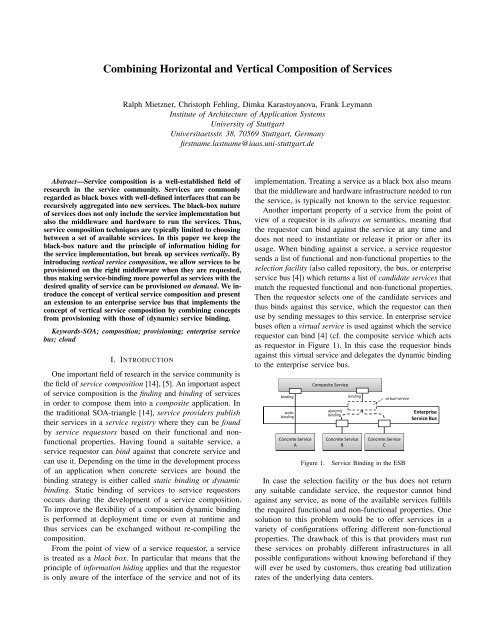Combining horizontal and vertical composition of services ... - IAAS
Combining horizontal and vertical composition of services ... - IAAS
Combining horizontal and vertical composition of services ... - IAAS
You also want an ePaper? Increase the reach of your titles
YUMPU automatically turns print PDFs into web optimized ePapers that Google loves.
<strong>Combining</strong> Horizontal <strong>and</strong> Vertical Composition <strong>of</strong> Services<br />
Ralph Mietzner, Christoph Fehling, Dimka Karastoyanova, Frank Leymann<br />
Institute <strong>of</strong> Architecture <strong>of</strong> Application Systems<br />
University <strong>of</strong> Stuttgart<br />
Universitaetsstr. 38, 70569 Stuttgart, Germany<br />
firstname.lastname@iaas.uni-stuttgart.de<br />
Abstract—Service <strong>composition</strong> is a well-established field <strong>of</strong><br />
research in the service community. Services are commonly<br />
regarded as black boxes with well-defined interfaces that can be<br />
recursively aggregated into new <strong>services</strong>. The black-box nature<br />
<strong>of</strong> <strong>services</strong> does not only include the service implementation but<br />
also the middleware <strong>and</strong> hardware to run the <strong>services</strong>. Thus,<br />
service <strong>composition</strong> techniques are typically limited to choosing<br />
between a set <strong>of</strong> available <strong>services</strong>. In this paper we keep the<br />
black-box nature <strong>and</strong> the principle <strong>of</strong> information hiding for<br />
the service implementation, but break up <strong>services</strong> <strong>vertical</strong>ly. By<br />
introducing <strong>vertical</strong> service <strong>composition</strong>, we allow <strong>services</strong> to be<br />
provisioned on the right middleware when they are requested,<br />
thus making service-binding more powerful as <strong>services</strong> with the<br />
desired quality <strong>of</strong> service can be provisioned on dem<strong>and</strong>. We introduce<br />
the concept <strong>of</strong> <strong>vertical</strong> service <strong>composition</strong> <strong>and</strong> present<br />
an extension to an enterprise service bus that implements the<br />
concept <strong>of</strong> <strong>vertical</strong> service <strong>composition</strong> by combining concepts<br />
from provisioning with those <strong>of</strong> (dynamic) service binding.<br />
Keywords-SOA; <strong>composition</strong>; provisioning; enterprise service<br />
bus; cloud<br />
I. INTRODUCTION<br />
One important field <strong>of</strong> research in the service community is<br />
the field <strong>of</strong> service <strong>composition</strong> [14], [5]. An important aspect<br />
<strong>of</strong> service <strong>composition</strong> is the finding <strong>and</strong> binding <strong>of</strong> <strong>services</strong><br />
in order to compose them into a composite application. In<br />
the traditional SOA-triangle [14], service providers publish<br />
their <strong>services</strong> in a service registry where they can be found<br />
by service requestors based on their functional <strong>and</strong> nonfunctional<br />
properties. Having found a suitable service, a<br />
service requestor can bind against that concrete service <strong>and</strong><br />
can use it. Depending on the time in the development process<br />
<strong>of</strong> an application when concrete <strong>services</strong> are bound the<br />
binding strategy is either called static binding or dynamic<br />
binding. Static binding <strong>of</strong> <strong>services</strong> to service requestors<br />
occurs during the development <strong>of</strong> a service <strong>composition</strong>.<br />
To improve the flexibility <strong>of</strong> a <strong>composition</strong> dynamic binding<br />
is performed at deployment time or even at runtime <strong>and</strong><br />
thus <strong>services</strong> can be exchanged without re-compiling the<br />
<strong>composition</strong>.<br />
From the point <strong>of</strong> view <strong>of</strong> a service requestor, a service<br />
is treated as a black box. In particular that means that the<br />
principle <strong>of</strong> information hiding applies <strong>and</strong> that the requestor<br />
is only aware <strong>of</strong> the interface <strong>of</strong> the service <strong>and</strong> not <strong>of</strong> its<br />
implementation. Treating a service as a black box also means<br />
that the middleware <strong>and</strong> hardware infrastructure needed to run<br />
the service, is typically not known to the service requestor.<br />
Another important property <strong>of</strong> a service from the point <strong>of</strong><br />
view <strong>of</strong> a requestor is its always on semantics, meaning that<br />
the requestor can bind against the service at any time <strong>and</strong><br />
does not need to instantiate or release it prior or after its<br />
usage. When binding against a service, a service requestor<br />
sends a list <strong>of</strong> functional <strong>and</strong> non-functional properties to the<br />
selection facility (also called repository, the bus, or enterprise<br />
service bus [4]) which returns a list <strong>of</strong> c<strong>and</strong>idate <strong>services</strong> that<br />
match the requested functional <strong>and</strong> non-functional properties.<br />
Then the requestor selects one <strong>of</strong> the c<strong>and</strong>idate <strong>services</strong> <strong>and</strong><br />
thus binds against this service, which the requestor can then<br />
use by sending messages to this service. In enterprise service<br />
buses <strong>of</strong>ten a virtual service is used against which the service<br />
requestor can bind [4] (cf. the composite service which acts<br />
as requestor in Figure 1). In this case the requestor binds<br />
against this virtual service <strong>and</strong> delegates the dynamic binding<br />
to the enterprise service bus.<br />
binding<br />
static<br />
binding<br />
Concrete Service<br />
A<br />
Composite Service<br />
Figure 1.<br />
dynamic<br />
binding<br />
binding<br />
Concrete Service<br />
B<br />
virtual service<br />
Concrete Service<br />
C<br />
Service Binding in the ESB<br />
Enterprise<br />
Service Bus<br />
In case the selection facility or the bus does not return<br />
any suitable c<strong>and</strong>idate service, the requestor cannot bind<br />
against any service, as none <strong>of</strong> the available <strong>services</strong> fullfils<br />
the required functional <strong>and</strong> non-functional properties. One<br />
solution to this problem would be to <strong>of</strong>fer <strong>services</strong> in a<br />
variety <strong>of</strong> configurations <strong>of</strong>fering different non-functional<br />
properties. The drawback <strong>of</strong> this is that providers must run<br />
these <strong>services</strong> on probably different infrastructures in all<br />
possible configurations without knowing beforeh<strong>and</strong> if they<br />
will ever be used by customers, thus creating bad utilization<br />
rates <strong>of</strong> the underlying data centers.
















